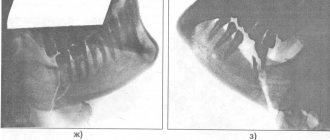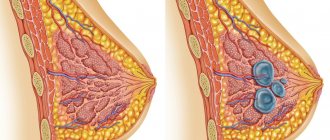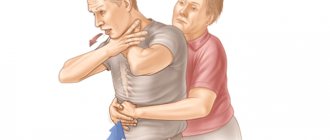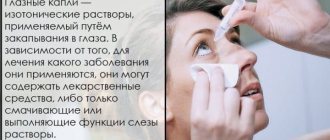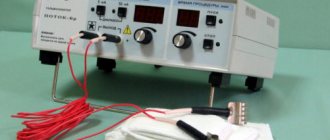Myopia is a visual impairment that manifests itself in early childhood in the vast majority of cases. However, there are situations when myopia begins to develop in an adult who previously had good vision or farsightedness. What factors can cause myopia? Let's talk about the main reasons.
With myopia, a person has difficulty distinguishing distant objects, but sees well up close, including small text and objects. Light rays entering the eye and refracting are focused not on the retina itself, but on the area in front of it. The reason for this may be
In this article
- Congenital myopia
- Acquired myopia
- Other reasons
- Complications of myopia
the increased size of the eyeball and its elongation along the anteroposterior axis, as well as an overly convex cornea, can refract light rays too much. Myopia, as a rule, is diagnosed in children at an early age; its development especially often coincides with the beginning of school, when the load on the child’s fragile visual apparatus increases many times over. It is also called “school” myopia, and it develops especially actively in the period from 8 to 12 years. There are two types of myopia: congenital and acquired.
general information
With myopia, the image is focused not on the surface of the retina, but in front of it. Because of this, sensitive cells receive incorrect information about the visible object. In order to focus the image on the retina, nearsighted people are forced to bring the object in question closer to their eyes.
This change can result from two mechanisms:
- excessive refraction of light inside the eye;
- elongation of the eyeball, which is observed more often.
At school age, myopia is registered in 10% of children; by graduation, its prevalence reaches 20%, and over the age of 25, about a quarter of people are myopic. Correction of myopia is a prerequisite for normal education and work.
Diagnostic methods
Diagnosis of the first stage of myopia
begins with collecting the patient's history and complaints. At this stage, the doctor establishes objective signs of myopia and conducts a series of studies to help determine the degree of pathological changes. For this, standard methods are used:
- measuring visual acuity using special tables - with letters for adult patients and figures for children;
- ophthalmoscopy - examination of the retina and fundus vessels;
- studies of static refraction (refractometry) to determine the functioning of the optical system and the difference in vision in both eyes;
- ergography or determination of accommodation (the functionality of the muscles responsible for changing the shape of the eyeball and lens);
- vitreous microscopy;
- Ultrasound of the eyeball or optical biometry, which detects changes in eye length.
The listed diagnostic methods allow not only to make a diagnosis, but also to discover the true causes of myopia. The data obtained is used to develop treatment and vision correction tactics.
Causes of myopia
The exact causes of myopia are unknown. It can be congenital and acquired. In the latter case, myopia usually occurs in childhood. In the future, it may stop developing (stationary form), or progressive myopia may develop, that is, a gradual deterioration of vision.
There is a hereditary predisposition to this disease. However, not all children whose parents are nearsighted develop myopia. For the formation of refractive errors, exposure to unfavorable factors is necessary:
- Unlimited time watching television or playing games, working on the computer;
- poor lighting of the workplace, child’s room;
- excessive visual load at a young age, if the child learned to read early;
- reading while lying down;
- poor posture, uncomfortable or incorrect body position during exercise.
A risk factor for congenital myopia is prematurity at birth.
Correcting myopia is possible only at the earliest stage of its development, therefore it is necessary to teach the child visual hygiene from an early age.
Symptoms of myopia
Signs of myopia in a child are usually noticed by parents or teachers:
- the child squints, brings drawings and objects close to his eyes;
- does not see educational materials on the board well, asks to move closer;
- stretches the corners of the eyes to see better.
The doctor's consultation
Make an appointment
The main symptoms of myopia:
- poor vision when looking at distant objects;
- rapid visual fatigue;
- headache, dry eyes, especially when watching TV for a long time, working at the computer, reading, driving a car.
If such signs appear, it is necessary to contact an ophthalmologist as soon as possible, who will advise how to restore vision in case of myopia or select correction means.
Fuchs' spot - what is it?
This unusual symptom usually occurs during degenerative processes in the retina. Fuchs' black spot forms at the site of fibrous and hemorrhagic lesions. Its appearance indicates a severe course of the disease. When this symptom is detected, as a rule, an unfavorable prognosis is made. Most likely, central vision will deteriorate even more.
Fuchs' spot is a pigmented lesion that forms in the very center of the macula. It almost always appears after hemorrhage in the macula with severe myopia. A new specific membrane appears in the retina. Blood vessels with ruptures begin to grow inside the membrane.
Symptoms of Fuchs' spot:
- appearance of distorted lines;
- black spots in the field of vision;
- Central vision deteriorates and its acuity decreases.
Pathological processes in the macula can develop over several years. However, they do not appear in any way. Sometimes the disease progresses rapidly. In such cases, vision decreases quickly.
This disease is treated with laser therapy. It is not always possible to get rid of Fuchs's spot. Some patients lose central vision permanently. The lateral aspect is preserved. Even after a successful operation, the patient should be observed by an ophthalmologist at least twice a year.
Degrees of myopia
The refractive power of the eye, as well as other lenses, is expressed in diopters. In myopia, to focus the image on the retina, a lens is needed that scatters light rays so that the image moves back. The optical power of a diverging lens is indicated with a minus sign. The larger its value, the more it shifts the image.
Myopia is divided into degrees depending on the required intensity of correction:
- weak – up to -3 diopters;
- average -3...-6 diopters;
- strong (heavy) – more than -6 diopters.
Treatment for myopia depends on its severity.
Therapeutic measures
Use of medications
To reduce tension in the intraocular muscles, a patient with congenital myopia may be prescribed medications in the form of drops. The most commonly prescribed drug is Atropine, which is used for a week. If premyopia or a mild degree of the disease is detected, then vitamin supplements are used, which include lutein. These means include:
- "Vitrum-vision";
- "Okuwait Lutein";
- "Lutein complex for children."
The initial manifestation of myopia is treated with the medications presented in the table:
| Group | Name |
| Drugs that prevent dystrophic processes | "Ascorutin" |
| "Dicynon" | |
| "Emoxipin" | |
| Medicines with absorbable action | "Fibrinolysin" |
| "Lidaza" | |
| "Collalysin" | |
| Products for physiotherapeutic procedures | "Diphenhydramine" |
| "Novocaine" | |
| "Calcium chloride" |
Massage treatments
Variable vacuum will help correct the child’s vision situation.
Manipulation helps cure mild to moderate myopia in children. The massage is performed using an alternating vacuum. Thanks to this treatment, ocular hydrodynamics are improved and blood circulation is normalized. A month later, parents may notice that the baby’s visual function has improved and the functioning of the ciliary muscle has stabilized.
Laser treatment
Such therapeutic methods are more effective and can cope with moderate degrees of myopia. Using this technique, it is possible to improve spatial vision and accommodation functions. The laser beam is fed to the display, which is placed at a distance of 10 cm from the eyeball. The images on the screen gradually change, and the child watches them. During the procedure, the function of the retinal nerve cells is stimulated, due to which the manifestation of myopia is reduced.
How does electrical stimulation work?
The manipulation helps eliminate signs of congenital myopia in young children. During the procedure, the eyeball is affected by a dosed current of low intensity. Thanks to this therapeutic method, it is possible to achieve increased conductivity of nerve impulses in the visual analyzer. Electrical stimulation does not cause any unpleasant or painful sensations in the patient.
When is surgery required?
If the disease continues to progress, the patient may be prescribed scleroplasty.
If conservative and physiotherapeutic treatment of myopia does not bring positive results, then surgery is prescribed. Scleroplasty is often performed, which is indicated in the following cases:
- myopia of 4 diopters or more;
- rapid increase in the anterior-posterior axis of the eyeball;
- rapid pathological course.
The operation can be performed only if there are no complications from the fundus of the eye. Through surgery for myopia, it is possible to strengthen the posterior pole of the eyeball, which reduces its growth. To improve blood flow to the damaged sclera, surgery is performed in 2 ways:
- Hemming the graft using donor sclera made of silicone or collagen.
- Injection into the back of the eyeball of a liquid containing crushed tissue.
Treatment and prevention of myopia
Treatment of myopia in children and adults includes:
- maintaining visual hygiene;
- a rational sleep pattern, working at the computer, reading, watching TV;
- eating sources of carotene, such as carrots;
- physiotherapeutic methods – laser stimulation, video-computer correction.
For weak and moderate myopia, the ophthalmologist selects stronger glasses for distance work and weaker glasses for near work. High myopia requires constant correction with glasses or contact lenses.
Surgery for myopia can be performed at varying degrees of severity of the disease, in order to slow the progression of the pathology or improve vision. The following treatment methods are used:
- scleroplasty - strengthening the back wall of the eye with muscles or other materials to prevent it from further stretching in the anteroposterior direction; the operation does not improve vision, but stops its progression;
- keratotomy - radial incisions on the cornea, changing its curvature, now this operation is rarely used;
- keratomileusis – removal of part of the cornea with a microkeratome for myopia of -15 diopters or more;
- removal of the clear lens – performed for some types of very severe myopia;
- photorefractive excimer laser keratectomy (PRK) – laser evaporation of the surface of the cornea, helps restore vision in mild to moderate myopia;
- LASIK technology (laser specialized keratomileusis) is a combination of keratomileusis and PRK, used not only for myopia, but also for its combination with astigmatism.
Prevention of myopia consists in eliminating all causes that provoke this disease. To slow down or prevent the progression of pathology, it is useful to do simple eye exercises for myopia:
- “draw” with your gaze the numbers from 0 to 9;
- turn your gaze clockwise, counterclockwise;
- examine the finger, bringing it closer to the nose, look outside the window;
- close your eyes tightly for a few seconds;
- lie on your back, close your eyes with your palms, imagine a dark starry sky above you.
How to treat retinal detachment?
Treatment is carried out using laser photocoagulation, during which the surgeon uses a laser to weld the retina into place. There are other methods - ballooning and filling. The choice of method is determined by medical indications. The main thing is to carry out the operation on time. It is not always possible to restore all lost visual functions to a person.
With high degrees of myopia, retinal detachment is one of the most common complications. Therefore, it is recommended to limit yourself to heavy physical activity, wear glasses or contact lenses for correction, and visit an ophthalmologist at least once a year. Pregnant women with myopia should be seen by an ophthalmologist much more often. Today, myopia and retinal detachment are not a death sentence. Laser coagulation is prescribed to patients even during pregnancy.
Why should you contact the Mama Papa Ya clinic?
The network of family clinics “Mama Papa Ya” invites patients of any age for an vision test and consultation with an ophthalmologist, as well as for the treatment of myopia. Why you should contact our specialists:
- branches of the clinic are located in different districts of Moscow;
- affordable prices for diagnostics and treatment;
- high-quality diagnostic equipment that makes it possible to accurately determine the degree of myopia and accompanying visual impairments;
- individual detailed consultation with an ophthalmologist on all issues related to eye health;
- service for the selection of glasses and contact lenses, moisturizing eye drops;
- accepting patients of any age.
Make an appointment with an ophthalmologist by phone or on our website.
Reviews
Marina Petrovna
The doctor carefully examined my husband, prescribed an ECG and made a preliminary diagnosis. She gave recommendations on our situation and ordered additional examination. No comments so far. Financial agreements have been met.
Roakh Efim Borisovich
I am simply delighted with the doctor and the clinic. I haven't had fun in clinics for a long time. Everything went perfectly from a logistics point of view, strictly on time. I also received aesthetic pleasure both as a patient and as a person. I could communicate and this communication gave me great pleasure. My deepest bow to the ultrasound doctor.
Luzina Sofya Khamitovna
I really liked Dr. Vlasova. Pleasant and sweet woman, a good specialist. I received an answer to all my questions, the doctor gave me a lot of good advice. I was more than satisfied with the visit.
Evgeniya
We visited the “Mama Papa Ya” Clinic with our child. A consultation with a pediatric cardiologist was needed. I liked the clinic. Good service, doctors. There was no queue, everything was the same price.
Olga
I really liked the clinic. Helpful staff. I had an appointment with gynecologist E.A. Mikhailova. I was satisfied, there are more such doctors. Thank you!!!
Anonymous user
I removed a lump from Alina Sergeevna, the operation was great! Many thanks to her for her sensitive attention and approach to every detail.
Anonymous user
Today I was treated at the clinic, I was satisfied with the staff, as well as the gynecologist. Everyone treats patients with respect and attention. Many thanks to them and continued prosperity.
Iratyev V.V.
The Mama Papa Ya clinic in Lyubertsy is very good. The team is friendly and responsive. I recommend this clinic to all my friends. Thanks to all doctors and administrators. I wish the clinic prosperity and many adequate clients.
Belova E.M.
Today I had a mole removed on my face from dermatologist I.A. Kodareva. The doctor is very neat! Correct! Thanks a lot! Administrator Yulia Borshchevskaya is friendly and accurately fulfills her duties.
Anonymous user
I would like to express my gratitude to the staff of the clinic: Mom, Dad, and me. The clinic has a very friendly atmosphere, a very friendly and cheerful team and highly qualified specialists. Thank you very much! I wish your clinic prosperity.
Christina
I liked the first visit. They examined me carefully, prescribed additional examinations, and gave me good recommendations. I will continue treatment further; I liked the conditions at the clinic.
Anna
Good clinic, good doctor! Raisa Vasilievna can clearly and clearly explain what the problem is. If something is wrong, she speaks about everything directly, not in a veiled way, as other doctors sometimes do. I don’t regret that I ended up with her.




